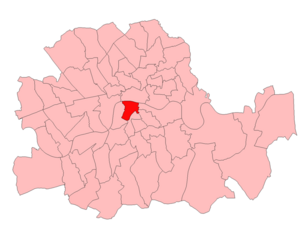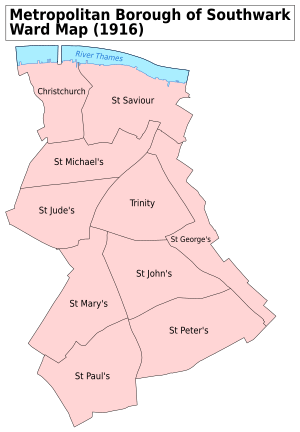Southwark North (UK Parliament constituency) facts for kids
Quick facts for kids {{{Name}}}[[{{{Type}}} constituency]] |
|
|---|---|
| [[Image:{{{Map1}}}Constituency.svg|120px|]] [[Image:England{{{Map2}}}.svg|120px|]] |
|
| {{{Name}}} shown within [[{{{Entity}}}]], and {{{Entity}}} shown within England | |
| Created: | {{{Year}}} |
| MP: | {{{MP}}} |
| Party: | {{{Party}}} |
| Type: | House of Commons |
| County: | [[{{{County}}}]] |
| EP constituency: | [[{{{EP}}} (European Parliament constituency)|{{{EP}}}]] |
Southwark North was a special area in South London that used to elect a person to represent it in the UK Parliament. This elected person is called a Member of Parliament (MP). The area was part of the Metropolitan Borough of Southwark.
Contents
What Was Southwark North?
Southwark North was a "constituency." Think of a constituency as a specific area on a map. People living in that area vote for one person to be their voice in the UK Parliament. This constituency was created for the election in 1918 and stopped being a separate area for elections in 1950. After 1950, most of its area became part of a new constituency called Southwark.
Where Was Southwark North Located?
The Southwark North constituency was in the Metropolitan Borough of Southwark. This is a part of London. It included several smaller areas called "wards." These wards were Christchurch, St. Jude, St. Michael, and St. Saviour. It also covered parts of other wards like Cathedrals and Chaucer.
Who Represented Southwark North?
The people who were elected as Members of Parliament (MPs) for Southwark North were:
| Election | Member | Party | |
|---|---|---|---|
| 1918 | Edward Strauss | Coalition Liberal | |
| 1922 | National Liberal | ||
| 1923 | Leslie Haden-Guest | Labour | |
| 1927 | Edward Strauss | Liberal | |
| 1929 | George Isaacs | Labour | |
| 1931 | Edward Strauss | National Liberal | |
| 1939 by-election | George Isaacs | Labour | |
| 1950 | constituency abolished: see Southwark | ||
Images for kids




